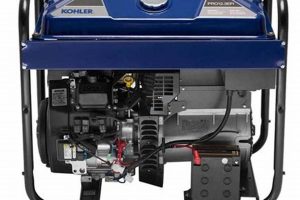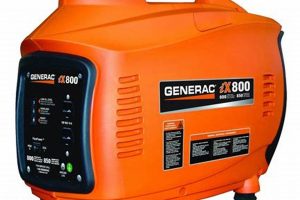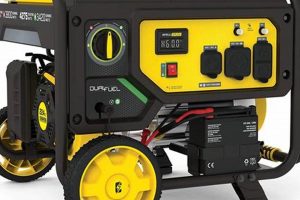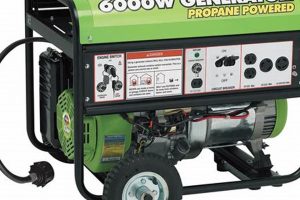A compact, fuel-driven electricity source, typically housed in a protective frame with handles or wheels for easy transport, utilizes propane as its primary fuel. These units offer a range of power outputs, making them suitable for diverse applications, from powering small appliances during camping trips to providing backup power for homes during outages. A typical example might feature multiple outlets, a built-in fuel gauge, and safety mechanisms like automatic shutoff features.
These independent power sources offer significant advantages in situations where grid electricity is unavailable or unreliable. Their portability allows for convenient deployment in remote locations or disaster-stricken areas. Propane’s relatively clean burning nature and ease of storage further enhance their practicality. Historically, the need for reliable, mobile power spurred the development of such generators, which have continually evolved in terms of efficiency, safety, and output. This evolution has made them indispensable tools for various industries, including construction, emergency services, and recreation.
The following sections will delve into specific aspects of these devices, covering topics such as proper operation and maintenance, safety considerations, selecting the appropriate size for specific needs, fuel efficiency and runtime estimations, and exploring the latest advancements in the field.
Operating Tips for Propane-Fueled Portable Generators
Safe and efficient operation ensures optimal performance and prolongs the lifespan of a propane-fueled portable generator. Attention to these key operational tips will maximize the benefits and minimize potential risks.
Tip 1: Proper Ventilation is Crucial: Always operate units in well-ventilated areas, outdoors and away from windows, doors, and vents. This prevents the accumulation of carbon monoxide, a colorless, odorless, and potentially lethal gas.
Tip 2: Level Surface Placement: Place the generator on a stable, level surface to ensure safe operation and prevent fuel spills. Avoid uneven or sloped terrain.
Tip 3: Regular Maintenance: Adhering to a regular maintenance schedule, including oil changes, air filter cleaning, and spark plug checks, ensures optimal performance and extends the generator’s operational life. Consult the manufacturer’s instructions for specific maintenance intervals.
Tip 4: Fuel Management: Use only approved propane fuel containers and connections. Check for leaks regularly and store fuel in a safe, well-ventilated area away from ignition sources.
Tip 5: Load Management: Avoid overloading the generator by exceeding its rated wattage capacity. Calculate the total wattage of devices to be connected and ensure it falls within the generator’s limits.
Tip 6: Safe Starting and Shutdown Procedures: Follow the manufacturer’s instructions for starting and shutting down the generator. Allow the unit to cool down before refueling or storing.
Tip 7: Professional Inspection: Periodic professional inspections can identify potential problems and ensure the generator continues to operate safely and efficiently.
By adhering to these operational guidelines, users can ensure the safe, reliable, and efficient performance of their propane-powered portable generators, maximizing their benefits for years to come.
This operational guidance provides a foundational understanding for safe and effective use. The following section will address frequently asked questions about these versatile power sources.
1. Portability
Portability represents a defining characteristic of these generators, directly influencing their utility across diverse applications. This inherent mobility stems from compact design, integrated handles or wheels, and relatively lightweight construction compared to stationary generators. The portability factor enables deployment in locations inaccessible to grid power, bridging the gap during outages and facilitating operations in remote areas. For instance, disaster relief efforts often rely on portable generators to power essential equipment in affected areas, while construction crews utilize them on sites lacking established power infrastructure. Without portability, these applications would face significant logistical challenges.
The practical implications of portability extend beyond mere convenience. Consider a homeowner facing a power outage. A portable unit allows them to maintain essential functions like refrigeration and lighting, mitigating disruption and spoilage. Similarly, outdoor enthusiasts benefit from the ability to power appliances and devices far from conventional power sources, enhancing recreational experiences. The portability factor also allows for rapid deployment during emergencies, providing critical power for medical equipment, communication devices, and other essential tools. This characteristic ultimately expands the scope of work and leisure activities, offering independence from fixed power sources.
In summary, portability significantly enhances the versatility and practicality of these generators. This feature allows for independent operation in diverse environments, from disaster relief scenarios to recreational activities. While considerations like fuel capacity and runtime remain important, portability directly influences the generator’s ability to fulfill its primary function: providing reliable power where and when it is needed most. Understanding the practical significance of portability empowers users to select the most appropriate generator for their specific needs and to effectively leverage its capabilities in various situations.
2. Propane Fuel
Propane fuel plays a critical role in the operation of portable generators, serving as the primary energy source that drives the engine and generates electricity. The relationship between propane and these generators is symbiotic; the generator provides a controlled environment for combustion, while propane delivers the necessary energy for operation. This reliance on propane offers distinct advantages. Propane’s clean-burning nature results in fewer emissions compared to gasoline, making it a more environmentally friendly option. Its widespread availability and ease of storage in readily available tanks further enhance its practicality. A real-life example of this can be seen in disaster relief efforts, where propane-powered generators provide essential power without contributing significantly to air pollution in already compromised environments. This characteristic also benefits users in recreational settings, minimizing environmental impact while enjoying outdoor activities.
The efficiency of propane combustion contributes to the overall performance and longevity of the generator. Clean combustion minimizes residue buildup within the engine, reducing maintenance requirements and extending operational lifespan. The stable nature of propane also contributes to reliable starts, even in cold weather conditions, a crucial factor for emergency preparedness and remote operations. For instance, in construction, consistent and reliable power is crucial for meeting project deadlines. Propane-powered generators offer this reliability, ensuring projects progress smoothly, even in challenging weather conditions or remote locations far from established power grids.
In summary, the relationship between propane fuel and portable generators is fundamental to their functionality and practical application. Propane’s clean-burning properties, ease of storage, and reliable combustion contribute significantly to the efficiency, longevity, and environmental friendliness of these power sources. Understanding this connection allows users to appreciate the advantages of propane-fueled generators, enabling informed decisions about fuel selection and operational practices. The benefits extend across diverse applications, from emergency preparedness and disaster relief to construction and recreational activities, highlighting the widespread impact of this essential energy source.
3. Power Generation
Power generation forms the core function of a portable propane-powered generator, transforming chemical energy stored within propane into usable electrical energy. This process, facilitated by the generator’s internal combustion engine and alternator, provides a crucial source of off-grid electricity for various applications, from powering essential appliances during outages to supporting operations in remote locations.
- Engine Operation
The engine, fueled by propane, drives the generator’s internal components. Combustion of propane within the engine cylinders generates mechanical energy, which is then transferred to the alternator. Different engine types, such as four-stroke or two-stroke engines, influence factors like fuel efficiency, noise levels, and maintenance requirements. For instance, a four-stroke engine generally offers better fuel efficiency and quieter operation compared to a two-stroke engine, making it suitable for extended use and noise-sensitive environments.
- Alternator Functionality
The alternator, a critical component connected to the engine, converts the mechanical energy from the engine’s rotation into electrical energy. This process utilizes electromagnetic induction to generate alternating current (AC) electricity. The alternator’s output capacity, measured in watts, determines the amount of power the generator can deliver. For example, a generator with a higher wattage output can power more devices or appliances simultaneously compared to a lower wattage unit. Understanding alternator specifications is crucial for selecting a generator that meets specific power demands.
- Power Output and Wattage
The generator’s power output, expressed in watts, represents its capacity to deliver electricity. This metric directly impacts the number and type of devices that can be powered simultaneously. Generators typically provide both a running wattage (for continuous operation) and a starting wattage (for appliances with high initial power demands). For instance, a refrigerator might require a higher starting wattage than its running wattage, and selecting a generator with sufficient starting wattage is crucial for ensuring reliable operation. Calculating the total wattage requirements of intended devices is essential for avoiding overload and ensuring consistent performance.
- Power Quality and Regulation
Maintaining consistent and stable power output is crucial for protecting sensitive electronic devices. Voltage regulation within the generator ensures a stable voltage supply, preventing fluctuations that could damage equipment. Some generators offer features like Automatic Voltage Regulation (AVR) for enhanced power quality, ensuring a cleaner and more stable power supply, suitable for sensitive electronics like computers and medical devices. This consistent power delivery is critical in professional settings, like mobile medical clinics or remote research stations, where equipment reliability is paramount.
These facets of power generation collectively determine a portable propane-powered generator’s performance and suitability for various applications. Understanding these elements empowers users to select the appropriate generator based on power requirements, fuel efficiency, and desired power quality. From emergency preparedness to recreational use, recognizing the interplay between engine operation, alternator function, power output, and regulation enhances the effective utilization and management of these versatile power sources.
4. Emergency Backup
Emergency backup power represents a critical function of portable propane-powered generators, providing a lifeline during unforeseen power outages. These outages, stemming from natural disasters, grid failures, or other disruptions, underscore the importance of reliable backup power solutions. Portable propane generators offer a practical and efficient means of mitigating the impact of such events, ensuring essential services and functions remain operational.
- Power Outage Response
Portable propane generators offer immediate power restoration during outages. Unlike permanently installed standby generators, portable units can be readily deployed to power critical appliances and systems. This rapid response capability minimizes disruption, preventing food spoilage, maintaining communication, and ensuring safety. During a severe storm causing widespread power outages, a portable generator can power refrigerators, sump pumps, and essential lighting, preserving food, preventing basement flooding, and maintaining a safe environment.
- Essential Appliance Operation
During emergencies, maintaining functionality of essential appliances is paramount. Portable generators provide the necessary power to operate refrigerators, freezers, sump pumps, medical equipment, and communication devices. This capability ensures access to food, prevents property damage from flooding, and enables continued access to critical medical care and communication. For individuals dependent on medical equipment requiring continuous power, a portable generator provides a crucial lifeline during outages, ensuring uninterrupted treatment.
- Communication Maintenance
Power outages often disrupt communication networks, isolating individuals and hindering access to emergency services. Portable generators enable continued operation of communication devices, including cell phones, radios, and internet modems, allowing individuals to stay informed, contact emergency services, and coordinate relief efforts. In disaster scenarios, maintaining communication can be crucial for coordinating rescue operations and accessing vital information.
- Safety and Security Enhancement
Power outages can compromise safety and security, particularly during nighttime hours. Portable generators power lighting systems, both indoors and outdoors, enhancing visibility and deterring potential security risks. This illumination provides a sense of security, facilitates movement within the home, and allows for essential tasks to be performed safely during extended power outages. In rural areas or during widespread disasters, exterior lighting powered by a portable generator can significantly improve safety and security.
The role of portable propane-powered generators in emergency backup scenarios extends beyond mere convenience. These versatile power sources provide essential support during critical situations, mitigating risks, ensuring safety, and maintaining vital services. Their portability, combined with the readily available fuel source, makes them an invaluable asset for homeowners, businesses, and emergency response teams alike, bridging the gap during power disruptions and fostering resilience in the face of unforeseen events.
5. Outdoor Activities
Portable propane-powered generators significantly enhance outdoor activities by providing a reliable, independent power source away from established electrical grids. This connection stems from the increasing demand for power in remote locations for recreational purposes, professional tasks, and emergency preparedness during outdoor excursions. The generator’s portability allows for convenient transportation to campsites, remote worksites, or disaster-stricken areas, ensuring essential devices and appliances function seamlessly. For example, campers can power lighting, cooking appliances, and electronic devices, while researchers conducting fieldwork can operate sensitive instruments and maintain communication. This capability enhances both leisure and professional activities conducted outdoors, fostering self-sufficiency and expanding the scope of operations in remote environments.
The practical significance of this connection lies in the enhanced safety, convenience, and productivity it offers. Power availability in remote locations improves safety by enabling communication, providing illumination, and facilitating the operation of essential equipment. Convenience increases with access to power for charging devices, running appliances, and supporting various tools, enhancing the overall outdoor experience. Productivity gains are realized in professional contexts, where tasks requiring power can be completed efficiently regardless of location. For instance, a film crew shooting in a remote location can utilize a generator to power lighting and cameras, ensuring uninterrupted production. Similarly, disaster relief teams can establish communication networks and power essential medical equipment in affected areas, facilitating effective response and recovery efforts.
In summary, the relationship between portable propane-powered generators and outdoor activities is symbiotic, driven by the need for independent power in remote environments. This connection enhances safety, convenience, and productivity across a range of applications, from recreational camping and professional fieldwork to emergency response and disaster relief. Understanding this interplay empowers individuals and organizations to operate effectively in off-grid locations, expanding the possibilities for work, leisure, and critical response in the outdoors. However, responsible usage, including adherence to safety guidelines and environmental considerations, remains paramount for maximizing the benefits and minimizing the impact of these power sources in natural settings.
6. Construction Sites
Construction sites and portable propane-powered generators share a crucial link, driven by the need for reliable, independent power in locations often lacking established electrical infrastructure. This connection stems from the power demands of construction equipment, the temporary nature of construction sites, and the frequent remoteness of project locations. Power tools, lighting systems, and specialized machinery require a consistent power supply, a need fulfilled by portable generators. The mobility of these generators allows for easy relocation within the site as project phases progress. Their self-contained nature eliminates dependence on grid connections, crucial in undeveloped areas or during initial construction phases. Consider a construction crew tasked with building a new road in a rural area. A portable generator can power essential tools like concrete mixers, saws, and welders, ensuring project continuity regardless of grid availability. This independence allows projects to commence and progress efficiently, unhindered by power limitations.
This reliance on portable generators has significant practical implications for construction operations. Project timelines often rely on uninterrupted power availability. Generators mitigate delays caused by power disruptions, ensuring deadlines are met and budgets are maintained. Worker safety improves with consistent power for lighting and safety equipment, minimizing risks associated with operating power tools in low-light conditions or using temporary wiring solutions. Furthermore, the ability to power specialized equipment expands the scope of construction projects that can be undertaken in remote or off-grid locations. For example, a remote pipeline construction project can utilize portable generators to power welding equipment and inspection tools, facilitating complex operations far from established infrastructure. This capability broadens the reach of construction activities, fostering development and infrastructure improvements in previously inaccessible areas. The fuel efficiency and emissions profile of the chosen generator also influence environmental impact, a factor of increasing importance in modern construction practices.
In summary, the connection between construction sites and portable propane-powered generators is essential for modern construction practices. This reliance stems from the industry’s need for mobile, independent power sources capable of supporting diverse equipment and ensuring project continuity. Portable generators directly impact project timelines, worker safety, and the feasibility of undertaking complex projects in remote locations. Understanding this relationship, and choosing generators appropriate for specific project needs, contributes significantly to the efficiency, safety, and overall success of construction endeavors. As technology advances, innovations in generator design, fuel efficiency, and emission control continue to refine this crucial partnership, shaping the future of construction power solutions. This understanding emphasizes the importance of selecting appropriate generators based on power output, fuel efficiency, and environmental considerations.
7. Remote Power Supply
Remote power supply represents a critical application of portable propane-powered generators, addressing the need for electricity in locations beyond the reach of established power grids. This connection arises from the increasing demand for power in off-grid environments for various purposes, including industrial operations, research activities, emergency response, and recreational pursuits. Portable generators offer a practical solution, providing independent power generation capabilities wherever needed. Their self-contained nature and portability facilitate deployment in diverse locations, from remote construction sites and disaster-stricken areas to scientific research stations and off-grid homesteads. This capability bridges the gap between power needs and accessibility, enabling operations and activities that would otherwise be significantly limited or impossible in areas lacking traditional power infrastructure.
- Off-Grid Functionality
Portable propane generators excel in off-grid environments, providing a reliable power source independent of established utility connections. This functionality is crucial for remote construction projects, enabling operation of power tools and machinery far from the grid. Scientific expeditions benefit from portable power for operating research equipment and maintaining communication in remote locations. Off-grid living, whether temporary or permanent, relies on generators for essential household electricity. For instance, a remote mining operation can utilize portable generators to power extraction equipment and on-site accommodations, while a scientific team studying wildlife in a remote forest can rely on a generator for powering cameras, sensors, and communication devices.
- Emergency Response and Disaster Relief
In disaster-stricken areas or regions experiencing prolonged power outages, portable generators provide essential electricity for emergency response and recovery efforts. These units power medical equipment, communication systems, lighting, and other critical tools needed for search and rescue operations, medical care, and the provision of essential services. Following a hurricane, portable generators can power temporary shelters, mobile medical clinics, and communication hubs, facilitating relief efforts and supporting affected communities. Their rapid deployability and independence from grid infrastructure make them invaluable assets in emergency situations.
- Recreational Activities and Remote Work
Portable generators enhance recreational activities in remote areas, powering appliances, lighting, and electronic devices at campsites, cabins, or during outdoor events. This capability enhances comfort, convenience, and safety during camping trips, hunting expeditions, and other outdoor pursuits. Remote work scenarios, such as fieldwork, environmental monitoring, or telecommunications maintenance, often rely on portable generators for powering essential equipment and ensuring continuous operation. A team installing telecommunications equipment on a remote mountaintop, for example, can utilize a portable generator to power their tools and maintain communication throughout the project.
- Cost-Effectiveness and Scalability
For remote locations where extending grid infrastructure is prohibitively expensive or impractical, portable propane generators offer a cost-effective power solution. Their modular nature allows for scalability, adapting power supply to specific needs. Smaller units suffice for basic power needs, while larger generators or multiple units operating in parallel can support more demanding applications. A small research team conducting field studies might require a single portable generator for powering laptops and sensors, while a larger-scale construction project in a remote area might utilize multiple generators to power heavy machinery and on-site accommodations, demonstrating the scalable nature of this power solution. This adaptability ensures cost-effectiveness and efficient resource allocation.
The relationship between portable propane-powered generators and remote power supply is fundamental to enabling operations and activities in off-grid locations. These generators provide crucial electrical power across diverse applications, from industrial projects and scientific research to emergency response and recreational pursuits. Understanding their versatility and recognizing the specific needs of each application are crucial for selecting the appropriate generator size, features, and operational practices. This informed approach maximizes efficiency, ensures safety, and fosters self-sufficiency in environments beyond the reach of traditional power sources, further emphasizing the importance of portable generators as essential tools in the modern world.
Frequently Asked Questions
This section addresses common inquiries regarding portable propane-powered generators, providing concise and informative responses to facilitate informed decision-making and safe operation.
Question 1: How is the appropriate generator size determined?
Generator size selection depends on the intended power requirements. Calculate the total wattage of devices planned for simultaneous operation, including starting wattage requirements, and select a generator with sufficient capacity. Consulting a wattage calculator or seeking professional guidance can ensure appropriate sizing.
Question 2: What safety precautions are essential during operation?
Operate generators outdoors in well-ventilated areas to prevent carbon monoxide poisoning. Ensure proper grounding to minimize electrical hazards. Never refuel a hot generator and store propane fuel safely away from ignition sources. Consult the manufacturer’s safety instructions for comprehensive guidance.
Question 3: How frequently should maintenance be performed?
Regular maintenance is crucial for optimal performance and longevity. Adhere to the manufacturer’s recommended maintenance schedule, including oil changes, air filter cleaning, and spark plug checks. Periodic professional inspections are also advisable for identifying potential issues.
Question 4: What is the typical runtime on a single propane tank?
Runtime varies depending on generator size, load, and tank capacity. Consult the manufacturer’s specifications for estimated runtime under various load conditions. Consider fuel consumption rates when planning for extended operation.
Question 5: What are the advantages of propane over gasoline for generators?
Propane offers several advantages, including cleaner combustion with reduced emissions, longer shelf life without degradation, and generally smoother engine operation. Propane also poses less risk of fuel spills and contamination compared to gasoline.
Question 6: What are the key considerations for storing a propane generator?
Store generators in a dry, well-ventilated area, protected from the elements. Disconnect the propane tank and ensure the generator is cool before storage. Consult the manufacturer’s storage recommendations for specific guidance.
Understanding these frequently asked questions contributes to safe and effective generator operation. Appropriate sizing, adherence to safety protocols, and regular maintenance maximize the generator’s lifespan and ensure reliable performance.
The following section explores various types of portable propane generators, highlighting the diverse options available to meet specific power needs and applications.
Conclusion
Portable propane-powered generators represent a versatile and reliable power solution for diverse applications. Their portability, combined with the clean-burning nature and readily available fuel source, makes them invaluable for emergency preparedness, outdoor activities, construction projects, and remote power supply. Understanding operational guidelines, safety precautions, and maintenance requirements ensures efficient and responsible usage. Careful consideration of power needs, fuel efficiency, and environmental impact facilitates informed selection and optimal performance. From powering essential appliances during outages to supporting complex operations in off-grid locations, these generators play a crucial role in modern society.
As technology advances, further advancements in generator design, fuel efficiency, and emission control are anticipated. Exploration of alternative fuels and integration of smart technologies may further enhance their capabilities and sustainability. The ongoing development and refinement of portable propane-powered generators promise continued enhancement of their role in providing reliable, independent power solutions for future needs, bridging the gap between power accessibility and diverse applications across various sectors.






